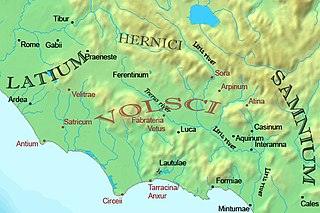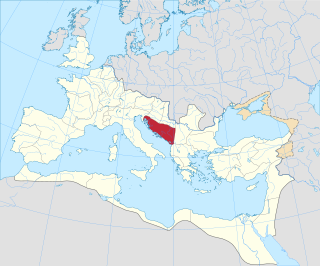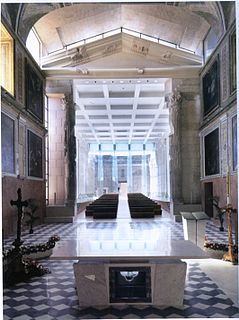
The Picts were a confederation of Celtic-speaking peoples who lived in what is today eastern and northern Scotland during the Late British Iron Age and Early Medieval periods. Where they lived and what their culture was like can be inferred from early medieval texts and Pictish stones. Their Latin name, Picti, appears in written records from Late Antiquity to the 10th century. They lived to the north of the rivers Forth and Clyde. Early medieval sources report the existence of a distinct Pictish language, which today is believed to have been an Insular Celtic language, closely related to the Brittonic spoken by the Britons who lived to the south.
AD 33 (XXXIII) was a common year starting on Thursday of the Julian calendar. At the time, it was known in the Roman world as the Year of the Consulship of Ocella and Sulla. The denomination AD 33 for this year has been used since the early medieval period, when the Anno Domini calendar era became the prevalent method in the world for naming years.

Seneca the Younger(c. 4 BC – AD 65), fully Lucius Annaeus Seneca and also known simply as Seneca, was a Roman Stoic philosopher, statesman, dramatist, and—in one work—satirist of the Silver Age of Latin literature.

Arrian of Nicomedia was a Greek historian, public servant, military commander and philosopher of the Roman period.

The Volsci were an Italic tribe, well known in the history of the first century of the Roman Republic. At the time they inhabited the partly hilly, partly marshy district of the south of Latium, bounded by the Aurunci and Samnites on the south, the Hernici on the east, and stretching roughly from Norba and Cora in the north to Antium in the south. Rivals of Rome for several hundred years, their territories were taken over by and assimilated into the growing republic by 300 BCE. Rome's first emperor Augustus was of Volscian descent.
This is a timeline of Roman history, comprising important legal and territorial changes and political events in the Roman Kingdom and Republic and the Roman and Byzantine Empires. To read about the background of these events, see Ancient Rome and History of the Byzantine Empire.

Africa Proconsularis was a Roman province on the northwest African coast that was established in 146 BC following the defeat of Carthage in the Third Punic War. It roughly comprised the territory of present-day Tunisia, the northeast of Algeria, and the coast of western Libya along the Gulf of Sirte. The territory was originally inhabited by Berber people, known in Latin as Mauri indigenous to all of North Africa west of Egypt; in the 9th century BC, Phoenicians built settlements along the Mediterranean Sea to facilitate shipping, of which Carthage rose to dominance in the 8th century until its conquest by the Roman Republic.

In historiography, ancient Rome is Roman civilization from the founding of the Italian city of Rome in the 8th century BC to the collapse of the Western Roman Empire in the 5th century AD, encompassing the Roman Kingdom, Roman Republic and Roman Empire until the fall of the western empire. The civilisation began as an Italic settlement in the Italian Peninsula, traditionally dated to 753 BC, that grew into the city of Rome and which subsequently gave its name to the empire over which it ruled and to the widespread civilisation the empire developed. The Roman Empire expanded to become one of the largest empires in the ancient world, still ruled from the city, with an estimated 50 to 90 million inhabitants covering 5.0 million square kilometres at its height in AD 117.

Pozzuoli is a city and comune of the Metropolitan City of Naples, in the Italian region of Campania. It is the main city of the Phlegrean Peninsula.

The Crypta Neapolitana, is an ancient Roman road tunnel near Naples, Italy. It was built in 37 BC, and is over 700 metres long.

Lucius Caesar was the grandson of Augustus. The son of Marcus Vipsanius Agrippa and Julia the Elder, Augustus' only daughter, Lucius was adopted by his grandfather along with his older brother, Gaius Caesar. As the emperor's adopted sons and joint-heirs to the Roman Empire, Lucius and Gaius had promising political and military careers. However, Lucius died of a sudden illness on 20 August AD 2, in Massilia, Gaul, while traveling to meet the Roman army in Hispania. His brother Gaius also died at a relatively young age on 21 February, AD 4. The untimely loss of both heirs compelled Augustus to redraw the line of succession by adopting Lucius' younger brother, Agrippa Postumus as well as his stepson, Tiberius on 26 June AD 4.

The book History of Rome, sometimes referred to as Ab Urbe Condita, is a monumental history of ancient Rome, written in Latin between 27 and 9 BC by the historian Titus Livius, or "Livy", as he is usually known in English. The work covers the period from the legends concerning the arrival of Aeneas and the refugees from the fall of Troy, to the city's founding in 753, the expulsion of the Kings in 509, and down to Livy's own time, during the reign of the emperor Augustus. The last event covered by Livy is the death of Drusus in 9 BC. About 25% of the work survives.

Lars Tolumnius, was the most famous king of the wealthy Etruscan city-state of Veii, roughly ten miles northwest of Rome, best remembered for instigating a war with Rome that ended in a decisive Roman victory.

Dalmatia was a Roman province. Its name is derived from the name of an Illyrian tribe called the Dalmatae, which lived in the central area of the eastern coast of the Adriatic Sea. It encompassed the northern part of present-day Albania, much of Croatia, Bosnia and Herzegovina, Montenegro, Kosovo and Serbia, thus covering an area significantly larger than the current Croatian region of Dalmatia. Originally this region was called Illyria or Illyricum.

Duncan Wu is a British academic and biographer.
This is a timeline of Italian history, comprising important legal and territorial changes and political events in Italy and its predecessor states, including Ancient Rome and Prehistoric Italy. Date of the prehistoric era are approximate. To read about the back ground check these events, see History of Italy. See also the list of Prime Ministers of Italy.
Ian S. Markham is an Episcopal priest and the Dean and President of Virginia Theological Seminary (VTS) since August 2007. Previously, he served at Hartford Seminary in Connecticut as Dean and Professor of Theology and Ethics.

The Temple of Quirinus was an ancient Roman temple built on the western half of the Quirinal Hill near the Capitolium Vetus, on a site which now equates to the junction between Via del Quirinale and Via delle Quattro Fontane, beside Piazza Barberini. Domitian later built the Temple of the gens Flavia nearby.

The Capitoline Brutus is an ancient Roman bronze bust commonly thought to depict the Roman consul Lucius Junius Brutus, usually dated to the late 4th to early 3rd centuries BC, but perhaps as late as the 2nd century BC, or early 1st century BC. The bust is 69 cm (27 in) in height and is currently located in the Hall of the Triumphs within the Capitoline Museums, Rome. Traditionally taken to be an early example of Roman portraiture and perhaps by an Etruscan artist influenced by Hellenistic art and contemporary Greek styles of portraiture, it may be "an archaizing work of the first century BC". The Roman head was provided with a toga-clad bronze bust during the Renaissance.

Pozzuoli Cathedral or the Basilica of San Procolo martire is the main Roman Catholic church in Pozzuoli and the seat of the Diocese of Pozzuoli. It sits at the top of the Rione Terra and is built around an ancient Roman temple.
















